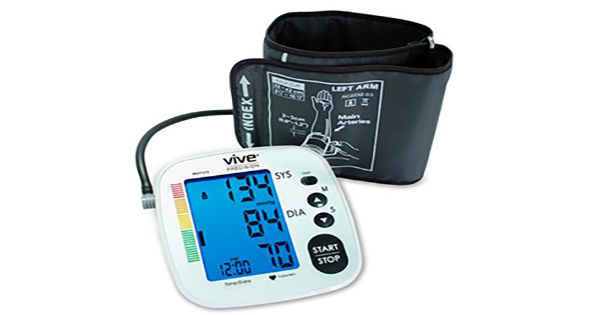Home Blood Pressure Monitor: A Review
 Monitoring blood pressure at home is one step you can take to supplement clinic monitoring for a more complete representation of your typical blood pressure throughout the day.
Monitoring blood pressure at home is one step you can take to supplement clinic monitoring for a more complete representation of your typical blood pressure throughout the day.
There are a wide variety of blood pressure monitors available. The American Heart Association, American Society of Hypertension, and Preventive Cardiovascular Nurses Association all recommend upper arm devices for greater accuracy. Avoid wrist and finger monitors.
When purchasing a home blood pressure monitor, it’s important you consult with your doctor or medical supply company to ensure you select an appropriate cuff size.
Vive Precision Blood Pressure Monitor
ViveHealth.com gifted me with a Vive Precision Blood Pressure Monitor along with compensation to review this device. That being said, all opinions in this review are my own.
The Vive blood pressure monitor comes with a large, easy to read display and is battery or AC power compatible. The product I received came packaged with the four AAA batteries needed. It did NOT come with the AC adapter. Looks like it requires a standard DC V6 adapter. I do like battery operated… one less cord to wrangle and the device notifies you if the battery power is getting low.
Easy to Use Blood Pressure Monitor
I’ve found the product to be very easy to use. From opening the box to taking my first reading was about 5 minutes. Keep in mind I have worked with blood pressure cuffs for years. All the parts were familiar to me. It might take you a little longer, but not much.
You do have to utilize the short manual that comes with the device. It’s not complicated to use with only three buttons, but the three buttons serve more than one function. You need the manual to set the date and time and to learn how to recall saved data.
It’s a two user device, so you and your spouse could store your data separately on the device. It stores a total of 250 records. However, I recommend you clear out the data regularly.
Discuss with your doctor how often they would like to receive your readings and then determine how you want to track your readings. Options include electronic trackers, such as smartphone applications, or paper trackers. Depending on how often your doctor wants to receive readings, you could potentially store a week’s worth of readings on the device, transfer to your paper or electronic tracker once a week, and then delete the stored data.
Blood Pressure Monitor Accuracy
While the Vive blood pressure monitor is FDA approved for accuracy, reading accuracy is the one piece I did not thoroughly test on the device. I took my blood pressure several different times with the Vive monitor and the readings are typical for me. However, with any home blood pressure monitor, you want to take it to your doctor’s office for a series of readings that are compared to readings from a standard blood pressure monitor. There is not currently a standard for how closely your home monitor should match the standard monitor readings, but this will give you an overall feel for your device accuracy. This is a comparison you should repeat annually to ensure your device continues to provide accurate data.
Review bottom line: The Vive Blood Pressure Monitor is easy to use and the memory storage makes it simple to track your readings. The cost of $30 is at the lower end of the range for a good quality monitor. Yes, you can find even cheaper options, but keep in mind, good quality monitors typically range from $50 to $100.
While it’s important to manage and monitor your blood pressure, it’s also essential you take steps to keep your blood pressure within healthy limits. Access the free e-course 7 Natural Ways to Lower Blood Pressure at http://lowerbloodpressurewithlisa.com.
All the best,
Lisa Nelson RD
Health Pro for HealthCentral



